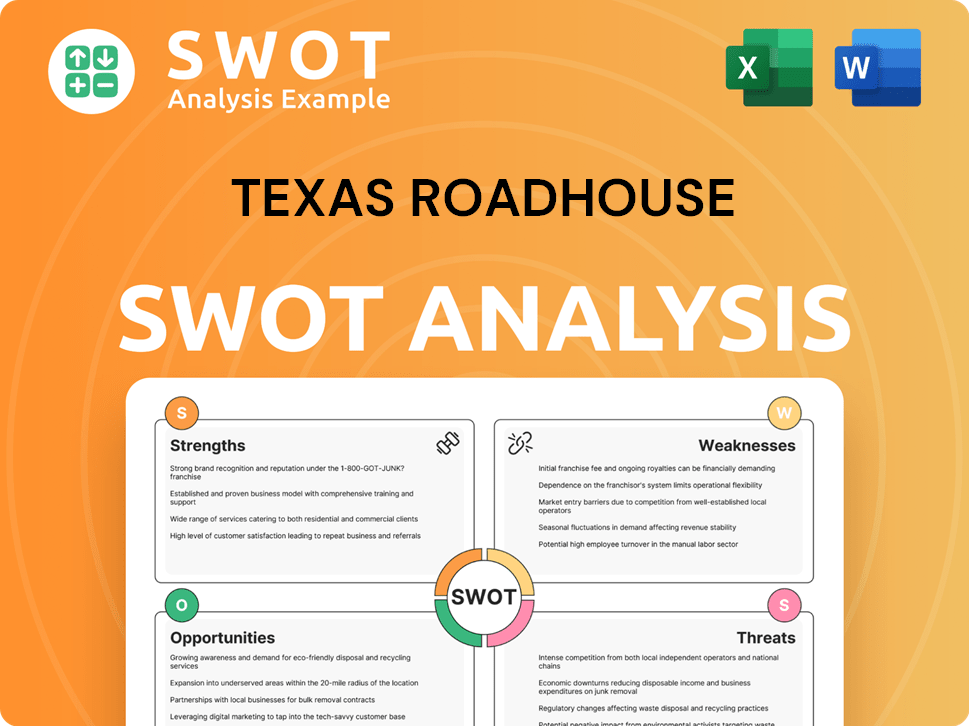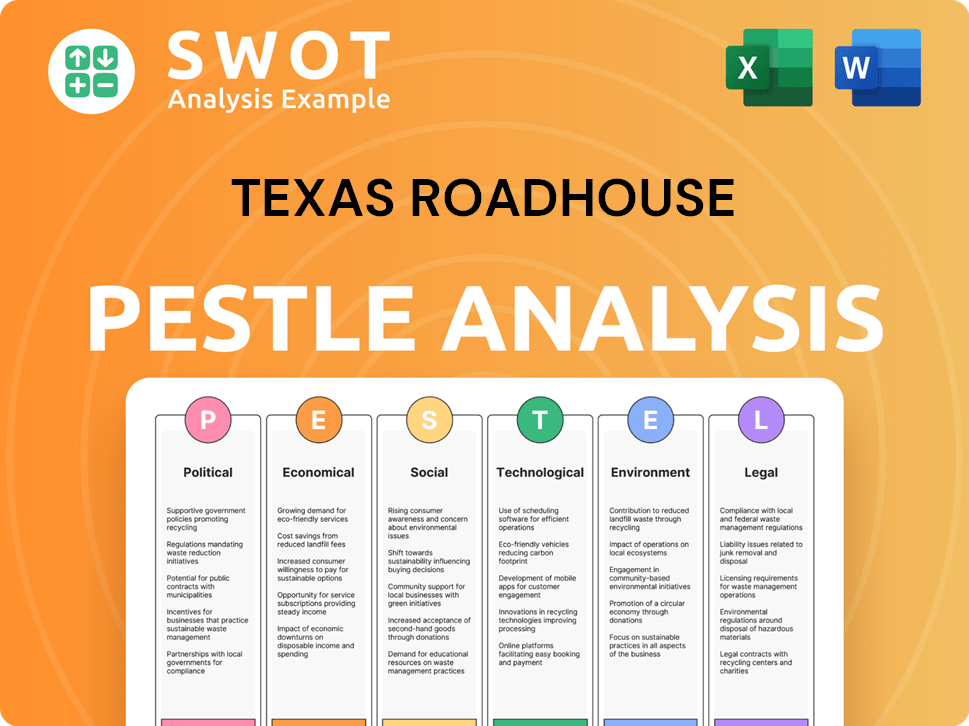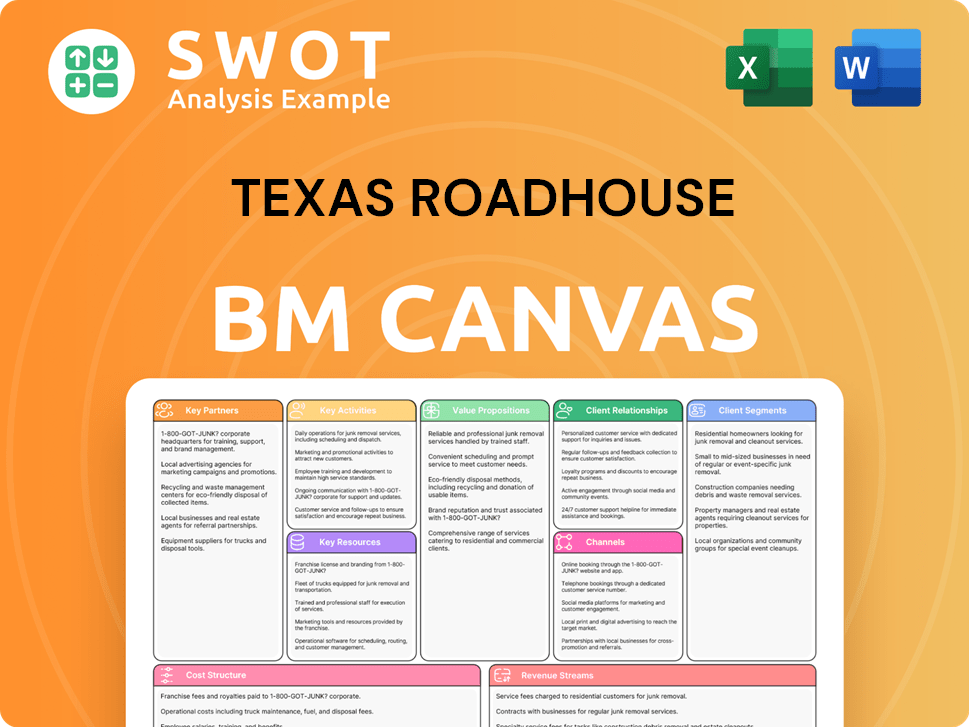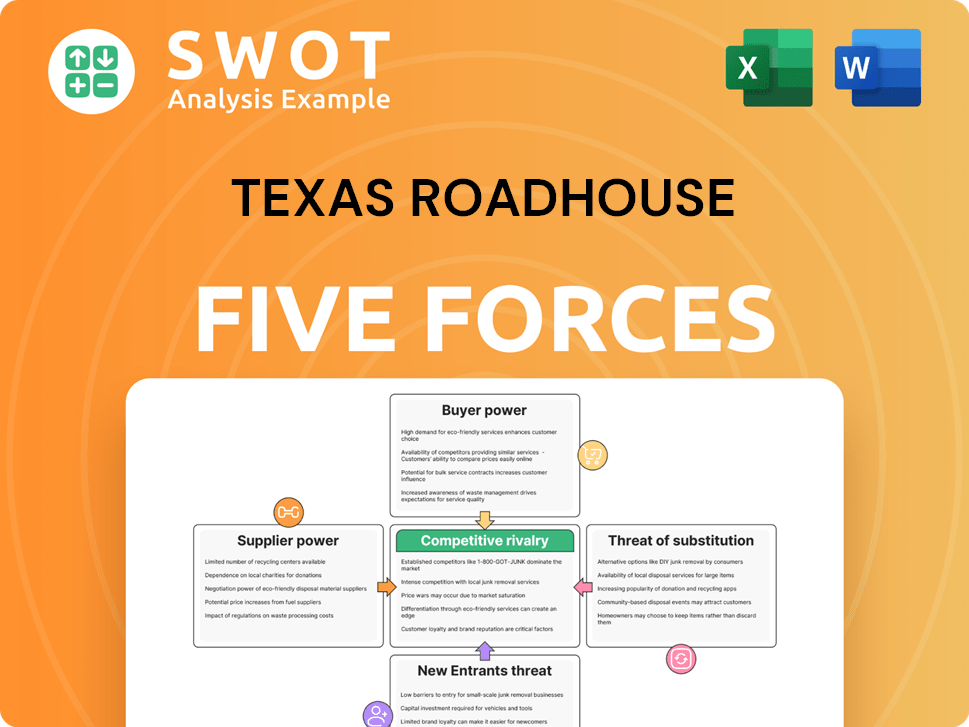Texas Roadhouse Bundle
Who's Eating at Texas Roadhouse?
In the bustling world of casual dining, understanding your customers is key to survival. Texas Roadhouse, a beloved name in the restaurant industry, has consistently thrived. But what makes their customer base tick, and how has this understanding fueled their success? This deep dive explores the Texas Roadhouse SWOT Analysis, revealing the secrets behind their enduring appeal.

This exploration of the Texas Roadhouse target market will uncover the customer demographics that define their success, examining their customer profile to understand their preferences, behaviors, and how Texas Roadhouse strategically caters to them. We'll answer questions like: Who are Texas Roadhouse's typical customers? What age range does Texas Roadhouse target? How does the restaurant industry demographics influence their strategy? This analysis offers actionable insights for anyone seeking to understand the power of a well-defined target audience.
Who Are Texas Roadhouse’s Main Customers?
The primary focus of the restaurant chain is on serving families, couples, and groups seeking a dining experience that balances affordability with quality. This approach allows the company to attract a diverse customer base. The strategy emphasizes providing a unique and consistent experience for individual diners and groups, focusing on value for money through generous portions at reasonable prices.
The customer base includes a wide range of individuals, from young adults to older patrons, all drawn to the signature offerings like hand-cut steaks and fall-off-the-bone ribs. The business model is primarily B2C (business-to-consumer), concentrating on delivering a consistent and enjoyable experience. This focus on value makes the restaurant particularly appealing to families and budget-conscious diners.
In 2024, the restaurant chain showed strong traffic growth, with comparable sales increasing by 8.5% for the full year, including 4.4% from traffic growth. This indicates the continued resonance of its value proposition across its target segments. The restaurant has maintained consistent performance by focusing on its core offerings and distinctive dining experience. The consistent traffic growth suggests a broad appeal that spans various demographic lines, united by a desire for quality, value, and a lively atmosphere.
The restaurant's customer base is diverse, encompassing various age groups and income levels. The target market includes families, couples, and groups who appreciate a casual dining environment. The restaurant's appeal cuts across different demographic lines, united by a desire for quality and value.
The primary segments include families, young adults, and older patrons. The restaurant focuses on providing a consistent dining experience. The emphasis is on value, offering generous portions at reasonable prices.
The target market is characterized by a preference for affordable dining options without compromising quality. Customers seek a lively atmosphere and a consistent dining experience. The restaurant's menu and pricing strategy cater to these preferences.
The value proposition, focusing on generous portions at reasonable prices, resonates strongly with families and budget-conscious diners. This strategy has contributed to consistent traffic growth and strong sales. The restaurant's approach ensures broad appeal across various demographic groups.
Understanding the customer demographics is crucial for the restaurant's success. The target audience includes a mix of ages and income levels, all seeking a quality dining experience. The restaurant's ability to maintain a consistent and enjoyable experience is key.
- The restaurant's customer profile includes families, couples, and groups.
- The focus on value and quality attracts a broad range of customers.
- Consistent traffic growth indicates the effectiveness of the target market strategy.
- The restaurant's approach supports its continued expansion and success.
Texas Roadhouse SWOT Analysis
- Complete SWOT Breakdown
- Fully Customizable
- Editable in Excel & Word
- Professional Formatting
- Investor-Ready Format

What Do Texas Roadhouse’s Customers Want?
Understanding customer needs and preferences is crucial for the success of any business, and Texas Roadhouse is no exception. Their approach focuses on providing quality food, value, and a welcoming atmosphere. This strategy has allowed them to build a loyal customer base and maintain a strong position in the competitive restaurant industry.
The restaurant's appeal lies in its commitment to offering hearty, made-from-scratch meals, with hand-cut steaks and freshly baked bread being key attractions. The dining experience is enhanced by exceptional customer service and a lively, country-themed ambiance, which fosters customer loyalty. This customer-centric approach is a key factor in their enduring popularity.
Texas Roadhouse's dedication to quality is evident in its food preparation standards and the use of high-quality ingredients. In 2024, 95% of customers rated their dining experience as 'excellent' or 'very good', highlighting the effectiveness of their approach. This focus on quality, combined with value, forms the core of their customer satisfaction strategy.
Customers are drawn to the perception of value for money, with generous portions offered at reasonable prices. This is a key factor in their purchasing decisions. The restaurant's pricing strategy is designed to attract and retain customers by providing a satisfying dining experience without excessive costs.
Consistency in food quality is a critical factor in customer decision-making. Texas Roadhouse ensures this through rigorous food preparation standards and the use of high-quality ingredients. This consistency builds trust and encourages repeat visits.
Exceptional customer service is a cornerstone of the Texas Roadhouse experience. Staff are trained to create a warm and welcoming atmosphere. This focus on service enhances the overall dining experience and fosters customer loyalty.
The lively, country-themed ambiance, complete with line dances and country music, enhances the dining experience. This unique entertainment element sets Texas Roadhouse apart and creates a memorable experience for customers. This contributes to the restaurant's distinctive brand identity.
The company addresses customer pain points by streamlining service through technology. The rollout of the 'Roadie First' technology system and digital kitchen upgrades aims to reduce wait times and boost efficiency. This improves the overall customer experience.
Feedback and market trends influence product development, such as the testing of a variety of mocktails to cater to evolving beverage preferences in 2025. This responsiveness to customer preferences ensures the menu remains appealing and relevant to the target audience.
Texas Roadhouse's success can be attributed to its customer-centric strategies, focusing on quality, value, and a welcoming atmosphere. The company's ability to adapt to changing market trends and customer preferences is crucial. Understanding the Competitors Landscape of Texas Roadhouse and customer demographics enables the company to refine its offerings and maintain its competitive edge.
- Menu Pricing: Maintaining a conservative approach to menu price increases, around 1.4% in early Q2 2025, to preserve the value proposition.
- Technological Advancements: Implementing systems like 'Roadie First' to improve service efficiency and reduce wait times.
- Product Development: Testing new menu items, such as mocktails, to cater to evolving customer preferences.
- Customer Feedback: Actively using customer feedback to refine offerings and improve the dining experience.
Texas Roadhouse PESTLE Analysis
- Covers All 6 PESTLE Categories
- No Research Needed – Save Hours of Work
- Built by Experts, Trusted by Consultants
- Instant Download, Ready to Use
- 100% Editable, Fully Customizable

Where does Texas Roadhouse operate?
The geographical market presence of Texas Roadhouse is primarily centered in the United States, with locations spanning across 49 states and one U.S. territory. As of June 2024, the chain operates approximately 655 locations, demonstrating a strong domestic footprint. This widespread presence is a key factor in understanding the customer demographics and the Texas Roadhouse target market.
Beyond the U.S., the company has established an international presence. There are 29 international locations across 11 countries, including Saudi Arabia, Kuwait, and Mexico. This international expansion strategy is designed to diversify revenue streams and reach a broader target audience. The company's growth strategy is detailed in Revenue Streams & Business Model of Texas Roadhouse.
Analysis of dining consumer preferences reveals regional variations. In 2024, Texas Roadhouse saw a greater share of visits in many Midwest and Mid-Atlantic CBSAs, indicating robust brand recognition in these areas. This contrasts with denser markets like California, Texas, and Florida, where competition may influence customer behavior.
Texas Roadhouse plans to open around 30 company-owned restaurants in 2024 and a similar number in 2025. This expansion includes new domestic and international locations, such as Mexico and the Middle East, to diversify revenue streams and cater to the target audience.
In early 2025, Texas Roadhouse announced a tentative agreement to acquire 13 restaurants from one of its largest domestic franchisees. This strategic move aims to consolidate its presence and enhance operational efficiency, further impacting the customer demographics.
The long-term objective is to reach 900 domestic Texas Roadhouse locations. The company aims for a total of about 1,000 locations across all its brands, including Bubba's 33 and Jaggers. This expansion often targets underserved markets, contributing to sustained growth and influencing the Texas Roadhouse customer profile.
The company's focus on underserved markets is a key element of its expansion strategy. Understanding the geographic location of Texas Roadhouse customers helps in defining the target audience and optimizing the restaurant's customer experience.
Texas Roadhouse Business Model Canvas
- Complete 9-Block Business Model Canvas
- Effortlessly Communicate Your Business Strategy
- Investor-Ready BMC Format
- 100% Editable and Customizable
- Clear and Structured Layout

How Does Texas Roadhouse Win & Keep Customers?
The success of Texas Roadhouse hinges on its ability to attract and keep customers. Their strategy centers on delivering consistent value and a unique dining experience. This approach has led to impressive traffic growth, with comparable sales increasing by 8.5% in 2024, including a 4.4% increase from traffic, demonstrating the effectiveness of their customer acquisition and retention efforts.
Texas Roadhouse's focus on value, atmosphere, and community engagement creates a loyal customer base. They avoid relying on national advertising, instead prioritizing a strong value proposition and memorable dining experience. This strategy has proven successful, as evidenced by their industry-leading traffic growth and high customer satisfaction scores.
Understanding the customer demographics and target market is crucial for Texas Roadhouse's continued success. By focusing on families and budget-conscious diners, the company ensures its value-driven approach resonates with its core customer base. This approach is further supported by local marketing and digital engagement strategies, which contribute to building strong community ties and enhancing the overall customer experience. For more details, check out the Marketing Strategy of Texas Roadhouse.
Texas Roadhouse offers generous portions at reasonable prices, appealing to families and budget-conscious diners. This focus on everyday value helps maintain customer loyalty, even with modest menu price increases. A 1.4% hike was implemented in early Q2 2025.
The lively atmosphere, country-themed décor, hand-cut steaks, and made-from-scratch sides create a memorable experience. Exceptional customer service and a welcoming environment further foster loyalty, encouraging repeat visits. This contributes to a positive Texas Roadhouse customer experience.
Texas Roadhouse builds strong community ties through local marketing initiatives. They also engage in community support, such as partnerships with organizations like the American Tinnitus Association. In 2024, 100% of profits from Dine-In and To-Go orders on a specific day were donated to the organization.
The VIP Club provides exclusive deals and rewards, including free appetizer coupons. Digital platforms like online waitlists and the Roadhouse Pay system enhance convenience. The pay-at-the-table option rolled out to most locations in 2023, improving the overall Texas Roadhouse customer behavior.
Investments in technology, such as the 'Roadie First' system and digital kitchen upgrades, streamline service. The full rollout of digital kitchen upgrades is expected by the end of 2025. A well-trained and motivated workforce enhances customer service.
- The 'Roadie First' system aims to improve employee efficiency and customer service.
- Digital kitchen upgrades are designed to reduce wait times and improve order accuracy.
- Employee training programs and fair compensation contribute to a positive work environment.
- The company also has an employee referral program, offering bonuses for successful new hires.
Texas Roadhouse Porter's Five Forces Analysis
- Covers All 5 Competitive Forces in Detail
- Structured for Consultants, Students, and Founders
- 100% Editable in Microsoft Word & Excel
- Instant Digital Download – Use Immediately
- Compatible with Mac & PC – Fully Unlocked

Related Blogs
- What are Mission Vision & Core Values of Texas Roadhouse Company?
- What is Competitive Landscape of Texas Roadhouse Company?
- What is Growth Strategy and Future Prospects of Texas Roadhouse Company?
- How Does Texas Roadhouse Company Work?
- What is Sales and Marketing Strategy of Texas Roadhouse Company?
- What is Brief History of Texas Roadhouse Company?
- Who Owns Texas Roadhouse Company?
Disclaimer
All information, articles, and product details provided on this website are for general informational and educational purposes only. We do not claim any ownership over, nor do we intend to infringe upon, any trademarks, copyrights, logos, brand names, or other intellectual property mentioned or depicted on this site. Such intellectual property remains the property of its respective owners, and any references here are made solely for identification or informational purposes, without implying any affiliation, endorsement, or partnership.
We make no representations or warranties, express or implied, regarding the accuracy, completeness, or suitability of any content or products presented. Nothing on this website should be construed as legal, tax, investment, financial, medical, or other professional advice. In addition, no part of this site—including articles or product references—constitutes a solicitation, recommendation, endorsement, advertisement, or offer to buy or sell any securities, franchises, or other financial instruments, particularly in jurisdictions where such activity would be unlawful.
All content is of a general nature and may not address the specific circumstances of any individual or entity. It is not a substitute for professional advice or services. Any actions you take based on the information provided here are strictly at your own risk. You accept full responsibility for any decisions or outcomes arising from your use of this website and agree to release us from any liability in connection with your use of, or reliance upon, the content or products found herein.